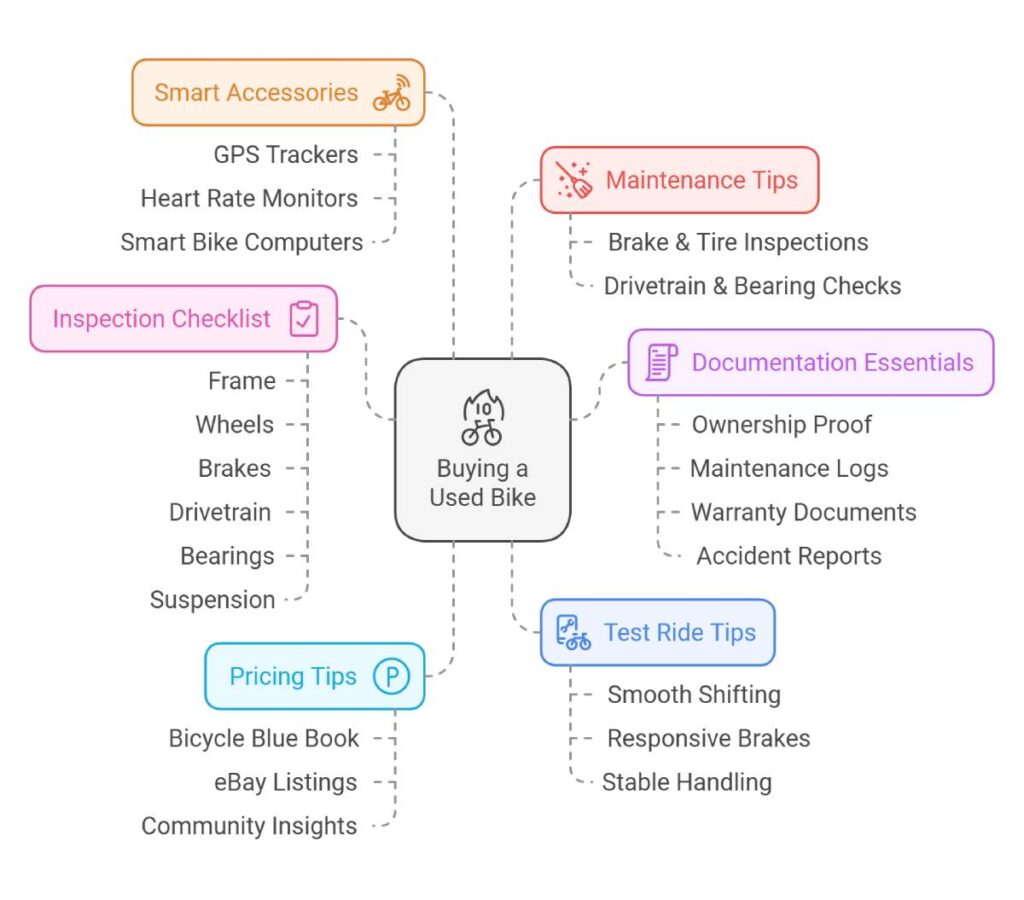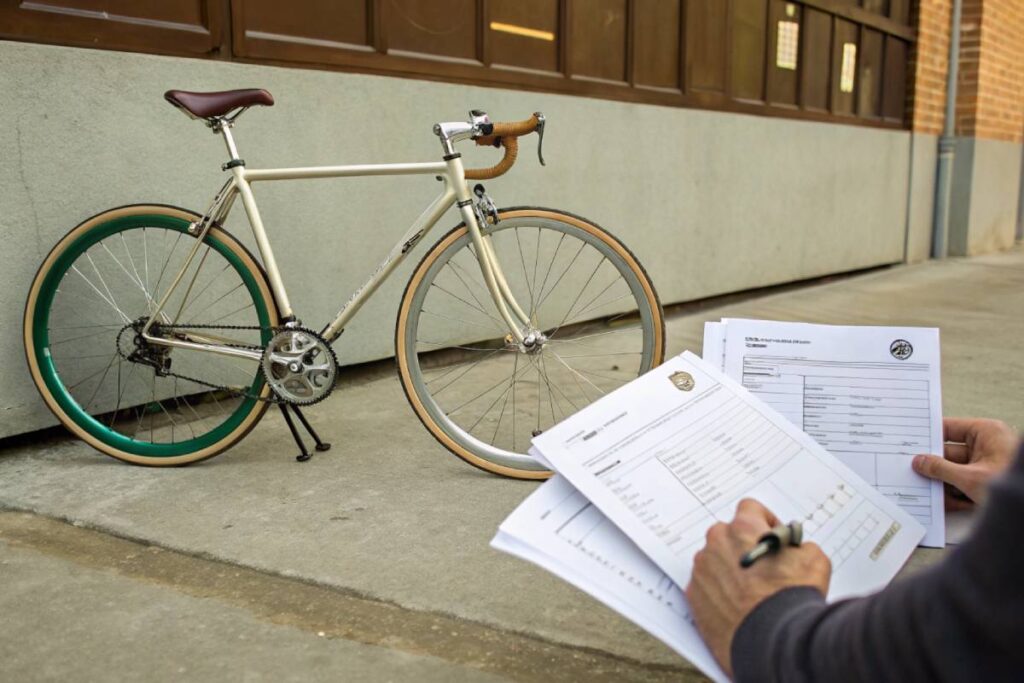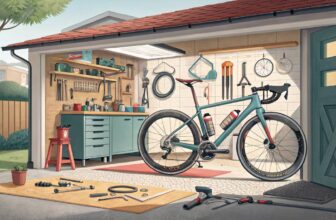Buying a used bike can be both exciting and daunting. Imagine finding the perfect ride without breaking the bank—but how do you ensure it’s in top condition?
Whether you’re a seasoned cyclist or a newbie, this comprehensive article equips you with the knowledge to evaluate, document, and negotiate like a pro. From spotting hidden damages to understanding essential paperwork, we’ve got you covered.
Dive in and ride confidently, knowing you’re making a smart investment in your next two-wheeled companion!
Evaluating Used Bikes
When considering a used bike, checking its condition is super important. Knowing what to eyeball can make sure you get a good deal and avoid buying a rusty lemon.
Assessing Bike Condition
Giving a bike a once-over ain’t just a matter of kicking the tires. Here’s your basic checklist:
- Frame: Spot any obvious damage? Little paint chips are no biggie but steer clear of anything with big dents, cracks, or Band-Aid fixes.
- Wheels: They should spin like a dream—no wobbling, no cracks lurking around.
- Fork: Look out for any bending or cracking.
- Brakes: Make sure pads and cables aren’t on their last legs.
- Drivetrain: Peek at the chain, cassette, and chainrings. Rust and excessive wear can spell trouble.
- Bearings: They ought to turn smooth as butter in the headset, bottom bracket, and wheel hubs.
- Suspension: For mountain bikes, ensure the suspension does its thing without hiccups.
| Component | What to Check for |
|---|---|
| Frame | Big dents, cracks, iffy touch-ups |
| Wheels | Bent rims, cracks, broken spokes |
| Fork | Bent or cracked |
| Brakes | Worn-down pads, frayed cables |
| Drivetrain | Rusty chain, weary cassette, battered chainrings |
| Bearings | Grinding or loose in the headset, bottom bracket |
| Suspension | Jerky motion, leaks, malfunctioning parts |
Need more elbow grease on this? Swing by our used bike inspection checklist for the full scoop.
Checking for Wear and Tear
Used bikes wear their age like a badge of honor. Here’s where to check under the hood:
- Paint and Stickers: Got dirt or peeling stickers? This might hint that the bike’s seen some rough days.
- Corrosion and Rust: Scope out the metal bits. Rust could mean the bike’s taken a beating from the elements.
- Tires: The tread should still have some kick. Steer clear of tires with cuts or cracking.
- Saddle: Scan for rips and any signs it’s worn to a nub.
- Handlebars and Grips: Look for shabby grips or bent bars, ’cause you don’t want your hands slipping.
Taking snaps and scribbling notes on these might just come in handy when haggling for a better price.
| Aspect | Signs of Age |
|---|---|
| Paint/Stickers | Dirt, peeling, faded designs |
| Metal Parts | Rust, any obvious corrosion |
| Tires | Worn tread, cracks, cuts |
| Saddle | Rips, worn areas |
| Handlebars/Grips | Grips past their prime, bent handlebars |
Curious about getting a bang for your buck? Check out our bike price guide so you don’t get ripped off. Also, our tips on how to negotiate bike price are solid gold.
By keeping these things in mind and scouring the bike like you’re Sherlock Holmes, you could bag yourself a sweet ride. If you need more tidbits, read up on bike frame sizing, check where to buy bikes, or debate new vs used bike without spilling your coffee.

Understanding Bike Documentation
Before you splurge on a new bike, get your paperwork game strong—know what you need to make a smart choice.
Importance of Documentation
Having the right papers can save your bacon. From the bike’s past life story to its latest tune-up, documentation keeps you on the up and up. Whether you’re a rookie rider, a parent shopping for the fam, or a seasoned pro jazzing up your wheels, good paperwork cuts the haggle and beefs up your argument just in case something goes sideways. Need to prove who’s at fault in a ding? Solid docs got your back.
Key Benefits of Proper Documentation:
- Proves you own it, there are no shady dealings
- Shows every wrench ever turned on it
- Spells out what’s covered by the warranty and insurance
- Helps you figure out if you’re overpaying
Essential Documents Checklist
Stay one step ahead by keeping tabs on these docs when you’re checking out that shiny bike. Perfect for the budget ninjas, brand sleuths, and bargain hunters.
| Document | Description |
|---|---|
| Ownership Proof | Title and registration papers are your go-to for confirming it’s yours and its specs. Peek at our bike registration guide. |
| Maintenance Logs | Service and repair records, telling the tale of the bike’s care. Check our bike maintenance plans. |
| Warranty Documents | Find out what’s what with warranty coverages. Swing by our bike warranty guide. |
| Accident Reports | Chronicles of any bumps and bruises. Dig deeper into accident paperwork in bike accident documentation. |
| Service Receipts | Documents every sprocket swapped, making you a savvy judge of bike condition. |
| Manufacturer Details | Original specs and manuals, handy for checking bits and bobs. Goes well with our bike component comparison. |
Grab pics and videos of the bike from all angles for the whole enchilada—handy to see what you’re really getting.

Rounding up these docs not only pegs the bike’s worth but also keeps you covered if things go wonky after riding off into the sunset. Use this checklist to stride into your next bike adventure with swagger. For more tips on sizing up bike prices, swing by our bike price guide, and check out our piece on where to buy bikes for more shopping smarts.
Pricing and Market Value
Getting the hang of what a used bike should cost is a big deal if you don’t want to spend more than you should. This is all about the little things you need to keep in mind and a few handy tools to help you make sure you’re not getting swindled.
Evaluating Fair Pricing
Figuring out what a used bike is worth isn’t just guesswork. You gotta look at a few things: the kind of bike it is, how old it is, and what shape it’s in.
Key Factors:
- Model and Year: The bike type and the year it rolled off the production line matter. Newer models usually cost more ’cause they come with all the fancy new gadgets.
- Condition: Take a really good look at how the bike’s been treated. Look for scratches, rust, and whether it’s been kept up with. If it looks spiffy, you can bet it’ll cost more. Want to know more about inspecting bikes? Check out the used bike inspection.
Here’s a quick chart to give you an idea of how a bike’s condition affects its price:
| Condition | Approximate Reduction from Original Price |
|---|---|
| Excellent | 10% – 20% |
| Good | 30% – 40% |
| Fair | 50% – 60% |
| Poor | 70% or more |
Utilizing Pricing Resources
Got a hunch about bike prices? Here are some places that’ll make sure you’re not overpaying.
Bicycle Blue Book
Pop over to the Bicycle Blue Book to check the going rate for used bikes. This site takes into account all sorts of stuff – model, year, condition – you name it.
eBay Sold Listings
Sneak a peek at what bikes are selling for on eBay. It’s a nifty way to see real prices, clear as day, showing how much folks are forking out for the same wheels.
Cycling Communities and Friends
Got a buddy who’s into biking? Maybe a group of them? Tap into their experience, they’re gold mines for knowing exactly what’s a fair shake price-wise.
By checking out these tools and keeping your wits about you, you’ll make sure you’re not paying too much for a used bike. For more tips, check out our guide on how to negotiate bike prices.
Inspecting Used Bikes
Buying a used bike ain’t just about the cash exchange—it’s about making sure you’re getting a ride that’s worth it. Let’s walk through the essential steps to kick those tires properly, from the up-close lookover to asking the right questions and taking it for a spin.
In-Person Inspection
So, you’re eyeing a shiny second-hand bike? Don’t get dazzled by ’em looks alone—give it a solid once-over! This is your chance to catch anything fishy or fixable before you’re stuck with a lemon. Here’s what to peek at:
- Frame and Fork: Check for cracks, dents, or rust lurking in the shadows.
- Tires and Wheels: Squeeze those tires, and spin the wheels to see if they dance or wobble.
- Brakes: Do the pads hold up, or are they balding? Squeeze them for dear life to check the bite.
- Chain and Sprockets: Rust or stiff links are bad news—smooth is the play here.
- Bearings: You want things rolling smoothly in the headset, bottom bracket, and wheel hubs.
- Cables and Housing: Frays and rust? Nah, it should feel slick and easy.
For the full detective rundown, check out our used bike inspection guide. Warhorse Camp Hill’s got a neat list too that’s worth a shuffle through.
Testing and Questioning
Spotted a potential winner? Sweet. Now it’s time for the real test—let’s see if this bike’s got the goods and dig into its past life.
Testing the Bike:
- Test Ride: The moment of truth. Feel for weird clunks or a wonky ride. Our guide on how to test ride a bike might come in handy here.
- Shifting Gears: Do a little dance with those gears—any skips or hiccups need attention.
- Braking: Give it a solid stop-test to rule out any squeaks or scraping sounds.
- Suspension (if applicable): Bounce it like you’re checking your bed. Weird noises mean trouble.
Questioning the Seller:
- Maintenance History: Slash through the BS—when was its last tune-up? What got fixed?
- Previous Owners: Who’s been riding it, and what kind of roads have they hit?
- Accidents or Repairs: Any crash-and-burn stories? Repairs matter—check our notes on bike accident documentation.
- Reason for Selling: Why’s this bike getting the boot?
- Modifications: Any cool upgrades? Or some wannabe speed mods?
Collect the goods by asking smart, not snooty. If you’re scratching your head for more questions, scoop deeper over at Ride Parc.
Bottom line, blend a sharp in-person once-over with a good ol’ ride and some serious seller-sleuthing to really nail down what the bike’s all about. Trust in the gut and those nudges of logic to snag a ride that’ll keep you happy. For more drama-free bike hunts, explore our bike inspection and bike buying mistakes pieces.
Bike Accident Documentation
Importance of Documentation
Taking notes after a bike mishap isn’t just important—it’s downright life-saving when you’re stuck in a bunch of he-said-she-said. This isn’t just about swapping scratches and stories; it’s about making sure everyone’s on the same page about who owes who a new wheel or a trip to the doctor.
Get it right, and you’re speeding up any insurance mumbo jumbo, keeping everything picture-perfect and clear-cut for everyone involved. It’s like having a referee at a soccer match—everyone knows what’s what.
Collecting Evidence
Photographs and Videos
Get that camera out because pictures and videos are the unsung heroes of truth. Snapshots of the bike, the busted street, and any crumpled fenders or paint scrapes. Road debris and skid marks are like nature’s way of pointing the finger. Videos get you even closer, showing off scratches and bumps from every angle. It’s your very own accident time capsule, letting you retrace the sequence with precision.
Personal Information
Gathering everyone’s deets is a must. Picture this: you’re in a crash with a stranger, and now you both gotta trade:
- Names
- Digits (Phone numbers)
- Addys (Addresses)
- Insurance info
It’s like when you’re trying to figure out who owes for the pizza—you need all the right pieces to solve the puzzle.
Witness Information
Eyewitnesses—those are the people who’ve got your back if it all goes down. Grab:
- Their full names
- How to call them (Contact numbers)
- Where to find ’em (Addresses)
Also, get in touch with the badges and medic folks that showed up. Write down officer names and badge digits. Their reports, coupled with docs from your doctor, can back you and boost the details around any boo-boos.
Technology Utilization
Tech is like your personal secretary here, with phones snapping pics and grabbing voices. Apps like iCloud, Google Drive, and Dropbox will stow your digital loot like it’s Fort Knox. Dashcams and GoPros spill the beans with continuous play-by-play. They’re your truth-tellers—unflinching proof of what went down.
| Method | Tool | Purpose |
|---|---|---|
| Photos/Videos | Smartphone | Capture evidence |
| Storage | iCloud, Google Drive, Dropbox | Organize/store evidence |
| Continuous Footage | Dashcam, GoPro | Capture ongoing activities |
Hungry for more info? Check out our savvy advice on keeping your bike in check. We’ve got killer resources on used bike inspection, bike price guides, and the nitty-gritty of bike insurance.
Maintenance and Checks
Keeping your bike running smoothly ain’t rocket science, you just gotta show it some love with regular upkeep. For folks just hopping onto the cycling bandwagon, knowing how to give your bike a good once-over can save you from some gnarly spills and cash down the road. In this bit, you’ll learn how to give your bike’s brakes, tires, drivetrain, and bearings a proper look-see.
Brake and Tire Inspections
Think of your bike’s brakes and tires like a lifeline—they’re your first line of defense. Let’s break down how to make sure they’re always ready to roll.
Brake Inspections
Before you hit the pavement, eyeball those brake pads; if they’re wearing thin or look lopsided, it’s time for a swap. Peek at the brake hoses for mysterious leaks and give the brakes a good squeeze while standing still.
- Brake pads: Leave at least 1.5mm of material there.
- Brake hoses: No cracks or leaks allowed.
- Brake fluid: Swap it out yearly for brakes with DOT fluid.
- Brake rotors: Bust out that caliper gauge to check if they’re worn.
| Brake Component | How Often to Check | Time to Replace |
|---|---|---|
| Brake Pads | Each ride | Less than 1.5mm |
| Brake Hoses | Every month | Cracks/Leaks |
| Brake Fluid | Each year | When dirty or dark |
| Brake Rotors | Month-to-month | As per the maker’s limits |
Tire Inspections
Give your tires the once-over for bare treads, cracks, and any shady business. Running tubeless? Make sure the sealant’s up to snuff.
- Tread wear: Watch out for smooth spots.
- Cracks: Sidewalls or tread looking dodgy.
- Tubeless sealant: Freshen it up every 3 months.
Drivetrain and Bearing Checks
Wanna keep your ride as slick as your last haircut? Focus on the drivetrain and bearings. Here’s how.
Drivetrain Checks
Bust out that chain wear gauge to know when it’s time to swap the chain. Look at the cassette and chainrings for wear, tidy up the drivetrain often, and spot-check those derailleur pulleys.
- Chain: Swap out every 500-1,000 miles or if wear hits over 0.5%.
- Cassette and Chainrings: Worn teeth? Time for replacements.
- Derailleur Pulley: Keep an eye out for wear or damage.
| Drivetrain Part | How Often to Peek | Swap it Out When |
|---|---|---|
| Chain | Weekly | Over 0.5% wear |
| Cassette | Monthly | Worn or broken teeth |
| Chainring | Every month | Teeth looking bad |
| Derailleur Pulley | Monthly | Showing wear or damage |
Bearing Checks
Give the bearings a whirl to see if they put up a fight or make funky sounds. Clean and lube the bearings before dirt and water do their worst.
- Bearings: Spin them to check for weirdness.
- Cleaning: Regular sprucing and greasing is key.
Stick with these steps, and your bike will be in tip-top shape, ready to take you wherever your journey ends up. If you want more nitty-gritty, check out our used bike inspection, and for pennies and dimes, have a look at the bike price guide.
Warranty Considerations
Checking out warranty options before buying a bike can keep you stress-free and help you choose wisely. Let’s take a closer look at what bike warranties cover and what they don’t.
Understanding Bike Warranties
Warranties act like a safety net against defects in parts or craftsmanship that might show up soon after you get your bike. Knowing the ins and outs of these warranties is key.
Big bike brands often promise lifetime warranties on main parts like frames and wheels. Keep an eye on what “lifetime” truly means, ’cause it can be quite the chameleon:
- How long has the original buyer kept the bike?
- How long the manufacturer thinks the bike should last based on their testing.
- The time span the maker keeps churning out that bike model.
Always give the warranty fine print a good read to get the scoop on what’s covered for your ride.
Other parts like the drivetrain, brakes, motors, and batteries might only come with short-term promises from their original makers, like Shimano or SRAM.
| Component | Typical Warranty |
|---|---|
| Frame | Lifetime |
| Wheels | Lifetime |
| Drivetrain | 1-2 years |
| Brakes | 1-2 years |
| Motors/Batteries | 1-2 years |
Source: Velosurance
Exclusions and Coverage
Bicycle warranties often have several loopholes, which means they skip covering certain types of issues or mishaps. Here are the usual suspects:
- Modifications: Tweaking or changing original parts can nix your warranty.
- Poor Maintenance: Skipping or skimping on routine checks can cut your coverage.
- Neglect or Abuse: If your bike gets trashed or ignored, your warranty might say “Not my problem.”
- Accidents: Crash damage? Mostly, you’re on your own there.
- Improper Assembly: If your bike wasn’t put together right, and not by a pro, kiss that warranty goodbye.
Warranties also usually don’t bother with everyday wear and tear from normal biking. Stick to the manufacturer’s upkeep schedule to keep your warranty solid for those new gadgets.
If something does go haywire, companies might recall bikes or parts under warranty. After a recall, your bike might not be covered under warranty until the defect is fixed. To get the lowdown on handling warranty troubles and knowing your rights, check out our full bike warranty guide.
Being in the know about these warranty twists and snags, be it for rookies, upgraders, or bike buffs, helps you steer your decision smartly. Want more pointers on checking out second-hand rides? Our section on used bike inspection is at your service, and for price insights, hit our bike price guide.
Smart Bike Accessories
Checking out bike accessories can seriously upgrade your cycling game, with gadgets that’ll make your ride smarter. Smart bike add-ons are a hit with newbies grabbing their first bikes, seasoned riders looking to amp up their gear, and families buying bikes for everyone.
Advanced Cycling Technology
Smart bike gear is all about tech that makes you faster and keeps you safer. Who doesn’t love a little help from the future?
Smart Bike Computers
Get yourself a spiffy bike computer with GPS to see how far you’re going, how fast you’re zooming, and even the hills you’re tackling. Planning your route? It’ll lead the way and keep you on track. You can link this gadget to other sensors too, like ones that measure your heart rate and power output. So you’re always in the know about how you’re performing.
| Feature | Description |
|---|---|
| GPS Tracking | Tracks your ride and speed |
| Navigation | Guides you with turn-by-turn directions |
| Sensor Connectivity | Hooks up to heart rate and power sensors |
Power Meters
These little devices measure your actual muscle grunt while pedaling. They help you set goals and make sure you’re training just right, so you get the most out of your effort.
Heart Rate Monitors
Keep tabs on your heart with real-time monitoring. This helps you figure out your fitness gains and ensures you’re training in the optimal range for getting fit.
Monitoring Tools
These gadgets help riders fine-tune their performance and keep their bikes in tip-top shape.
Cadence Monitors
Wanna know how fast those pedals are spinning? Cadence monitors tell you how many times your feet go around in a minute. Keeping an eye on this lets you balance speed and energy (thanks to the folks over at Pro Cycling Coaching).
Smart Trainers
When the weather’s not cooperating, a smart trainer transforms your bike into an indoor ride. Pair it with apps like Zwift, and you’ve got yourself a virtual track and a global community to ride with.
| Tool | Function |
|---|---|
| Cadence Monitor | Keeps tabs on your pedal RPM |
| Smart Trainer | Turns your bike into an indoor workout unit |
| Heart Rate Monitor | Tracks fitness levels through heart rate |
Smart bike gear lets cyclists use data to get better and better, ensuring every ride is a step forward. For more on bike care, check out brake and tire inspections, drivetrain and bearing checks, and used bike inspections.
If you’re hunting for more info on buying and caring for bikes and accessories, browse through the bike finance guide, where to buy bikes and smart bike technology options. Feel confident about the best bikes by price, and don’t forget to peek at bike warranty considerations to keep your ride safe and sound.
Conclusion
Purchasing a used bike doesn’t have to be a gamble. With the right knowledge and tools, you can confidently assess a bike’s condition, understand its history, and determine its true value.
Our Guide equips you with essential checklists for evaluating frames, wheels, brakes, and more, ensuring you avoid common pitfalls like rusted components or hidden damages. Proper documentation is your safeguard, providing transparency and security in your purchase.
Additionally, understanding pricing strategies and utilizing resources like Bicycle Blue Book can help you negotiate effectively, ensuring you get the best deal. Regular maintenance checks and being aware of warranty terms further protect your investment, keeping your ride smooth and reliable.
Embrace smart accessories to enhance your cycling experience, making every journey safer and more enjoyable. Whether you’re a novice or a seasoned rider, this guide empowers you to make informed decisions, ensuring your next used bike is a perfect match for your cycling adventures.
FAQs
1. What are the most critical parts to inspect when buying a used bike?
When buying a used bike, focus on the frame, wheels, brakes, drivetrain, bearings, and suspension (if applicable). Look for signs of damage, excessive wear, and rust, and ensure all components function smoothly.
2. Why is documentation important when purchasing a used bike?
Proper documentation verifies ownership, tracks maintenance history, outlines warranty coverage, and provides essential information in case of accidents or disputes, ensuring a transparent and secure transaction.
3. How can I determine the fair market value of a used bike?
Use resources like the Bicycle Blue Book, eBay sold listings, and insights from cycling communities. Consider the bike’s model, year, condition, and any included accessories to assess its true value.
4. What should I look for during a test ride of a used bike?
During a test ride, check for smooth shifting, responsive braking, stable handling, and any unusual noises or vibrations. Ensure the suspension works correctly if it’s a mountain bike and that the ride feels comfortable.
5. What are common exclusions in bike warranties?
Warranties typically exclude modifications, poor maintenance, neglect or abuse, accident damage, and improper assembly. They also often don’t cover everyday wear and tear from regular use.
Final Thoughts
Navigating the world of used bike purchases can be overwhelming, but with the insights from our Bike Buyers Bible, you’re well-equipped to make smart, informed decisions.
Remember, the key lies in meticulous evaluation, thorough documentation, and understanding the market dynamics. Don’t rush the process—take your time to inspect every component, ask the right questions, and leverage available resources to verify the bike’s value and history.
Maintenance isn’t just about preserving the bike’s functionality; it’s about ensuring your safety and enhancing your riding experience. Embrace the advancements in smart bike technology to stay ahead in your cycling journey.
By following these guidelines, you’ll not only secure a quality used bike but also enjoy countless rides with confidence and peace of mind. Happy cycling!
Key Tips
- Thorough Inspection: Always perform a detailed check of the bike’s frame, wheels, brakes, and drivetrain before purchasing.
- Document Everything: Keep records of ownership, maintenance, and any repairs to ensure transparency and protect your investment.
- Research Pricing: Use multiple resources like Bicycle Blue Book and eBay to understand the fair market value of the bike you’re interested in.
- Test Ride: Never skip the test ride. It’s the best way to assess the bike’s performance and comfort.
- Regular Maintenance: Keep your bike in top condition with routine checks on brakes, tires, drivetrain, and bearings.
- Understand Warranties: Read the fine print of any warranty to know what’s covered and avoid unexpected costs.
- Upgrade Smartly: Invest in smart accessories that enhance your ride without breaking the bank.
Recommended Biking Products and Accessories
- Bike Computer with GPS: Garmin Edge 530 – Track your rides, navigation, and performance metrics.
- Heart Rate Monitor: Wahoo TICKR – Monitor your fitness levels in real time.
- Smart Trainer: Wahoo KICKR – Turn your bike into an indoor training unit with virtual apps.
- Chain Wear Gauge: Park Tool CC-3.2 – Ensure your chain is in optimal condition.
- Bike Maintenance Kit: BikeTool Home Mechanic Kit – All the essential tools for regular bike upkeep.
- Smart Bike Lights: Cygolite Metro Pro 1100 – Enhance safety with bright, programmable lighting.
- Tubeless Tire Sealant: Stan’s NoTubes – Maintain your tires and prevent flats on the go.
- Bike Lock: Kryptonite New York Fahgettaboudit Mini – Secure your bike with top-tier protection.
- Suspension Pump: Fox Float DPS Pump – Adjust your bike’s suspension for a smooth ride.
- Bike Repair Stand: Feedback Sports Pro Repair Stand – Conveniently work on your bike at home.
By integrating these products into your biking routine, you can enhance performance, ensure safety, and maintain your bike’s longevity, making every ride a pleasure.




